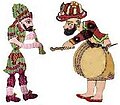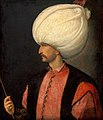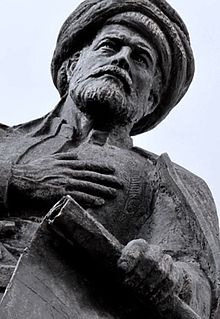Our website is made possible by displaying online advertisements to our visitors.
Please consider supporting us by disabling your ad blocker.
Portal:Turkey
Merhaba! Türkiye portalına hoş geldiniz. Hi! Welcome to the Turkey portal.
 | |

| |
Turkey, officially the Republic of Türkiye, is a country mainly located in Anatolia in West Asia, with a small part called East Thrace in Southeast Europe. It borders the Black Sea to the north; Georgia, Armenia, Azerbaijan, and Iran to the east; Iraq, Syria, and the Mediterranean Sea to the south; and the Aegean Sea, Greece, and Bulgaria to the west. Turkey is home to over 85 million people; most are ethnic Turks, while ethnic Kurds are the largest ethnic minority. Officially a secular state, Turkey has a Muslim-majority population. Ankara is Turkey's capital and second-largest city, while Istanbul is its largest city and economic and financial center. Other major cities include İzmir, Bursa, and Antalya.
Turkey was first inhabited by modern humans during the Late Paleolithic. Home to important Neolithic sites like Göbekli Tepe and some of the earliest farming areas, present-day Turkey was inhabited by various ancient peoples. The Hattians were assimilated by the Anatolian peoples, such as the Hittites. Classical Anatolia transitioned into cultural Hellenization following the conquests of Alexander the Great; Hellenization continued during the Roman and Byzantine eras. The Seljuk Turks began migrating into Anatolia in the 11th century, starting the Turkification process. The Seljuk Sultanate of Rum ruled Anatolia until the Mongol invasion in 1243, when it disintegrated into Turkish principalities. Beginning in 1299, the Ottomans united the principalities and expanded. Mehmed II conquered Constantinople (now known as Istanbul) in 1453. During the reigns of Selim I and Suleiman the Magnificent, the Ottoman Empire became a global power. From 1789 onwards, the empire saw a major transformation, reforms, and centralization while its territory declined.
In the 19th and early 20th centuries, persecution of Muslims during the Ottoman contraction and in the Russian Empire resulted in large-scale loss of life and mass migration into modern-day Turkey from the Balkans, Caucasus, and Crimea. Under the control of the Three Pashas, the Ottoman Empire entered World War I in 1914, during which the Ottoman government committed genocides against its Armenian, Greek, and Assyrian subjects. Following Ottoman defeat, the Turkish War of Independence resulted in the abolition of the sultanate and the signing of the Treaty of Lausanne. The Republic was proclaimed on 29 October 1923, modelled on the reforms initiated by the country's first president, Mustafa Kemal Atatürk. Turkey remained neutral during most of World War II, but was involved in the Korean War. Several military interventions interfered with the transition to a multi-party system.
Turkey is an upper-middle-income and emerging country; its economy is the world's 17th-largest by nominal and 12th-largest by PPP-adjusted GDP. It is a unitary presidential republic. Turkey is a founding member of the OECD, G20, and Organization of Turkic States. With a geopolitically significant location, Turkey is a regional power and an early member of NATO. An EU candidate, Turkey is part of the EU Customs Union, CoE, OIC, and TURKSOY.
Turkey has coastal plains, a high central plateau, and various mountain ranges; its climate is temperate with harsher conditions in the interior. Home to three biodiversity hotspots, Turkey is prone to frequent earthquakes and is highly vulnerable to climate change. Turkey has a universal healthcare system, growing access to education, and increasing levels of innovativeness. It is a leading TV content exporter. With 21 UNESCO World Heritage sites, 30 UNESCO intangible cultural heritage inscriptions, and a rich and diverse cuisine, Turkey is the fifth most visited country in the world. (Full article...)
Selected article -
The 1915 Çanakkale Bridge (Turkish: 1915 Çanakkale Köprüsü) is a road suspension bridge in the province of Çanakkale in northwestern Turkey. Situated just south of the coastal towns of Lapseki and Gelibolu, the bridge spans the Dardanelles, about 10 km (6.2 mi) south of the Sea of Marmara. The bridge is the longest suspension bridge in the world—with a main span of 2,023 m (2.023 km; 1.257 mi), the bridge surpasses the Akashi Kaikyo Bridge (1998) in Japan by 32 m (105 ft).
The bridge was officially opened by President Recep Tayyip Erdoğan on 18 March 2022 after roughly five years of construction. It is the centrepiece of the planned 321-kilometre-long (199 mi) US$2.8 billion O-6 motorway, which will connect the O-3 and O-7 motorways in East Thrace to the O-5 motorway in Anatolia. The year "1915" in the official Turkish name honours an important Ottoman victory in the Gallipoli campaign comprising a naval engagement followed by a land invasion on the Gallipoli peninsula by the forces of Australia, New Zealand (The ANZACS), France and Great Britain from 25 April 1915 which were largely evacuated by December of that year. (Full article...)
General images
Did you know -
- ... that Denis Legerský was allowed to play for the Turkish national ice hockey team in a friendly match in 2014, even though he is a Slovak citizen? (April 11, 2014)
- ... that the third officer of the MV Horizon-1, a cargo ship recently hijacked by Somali pirates, is a 24-year old Turkish woman? (July 27, 2009) Wikipedia:Recent additions 246
- ... that the 1993 Bayburt Üzengili avalanche in north-eastern Turkey killed 59 people and 650 livestock, and caused the relocation of the village to a safe zone? (October 20, 2010)
- ... that the broken top of the Aviation Martyrs' Monument in Istanbul is to symbolize the incomplete status of the flight missions? (September 21, 2010)
- ... that Karaköy, part of ancient Galata, and an important commercial and transport center at the Golden Horn, was the birthplace of André Chénier, a French poet beheaded during the French Revolution? (March 16, 2007) Wikipedia:Recent additions 127
- ... that Yavuz Yapıcıoğlu, nicknamed the "Screwdriver Killer", is the serial killer with the highest known victim count in Turkey? (March 22, 2014)
- ... that the world's longest tunnel system is the two parallel tunnels at the Atatürk Dam of Şanlıurfa in southeastern Turkey? (February 14, 2008)
Selected picture
Selected biography -
Muhiddin Piri (c. 1470 – 1553), better known as Piri Reis (Turkish: Pîrî Reis), was an Ottoman cartographer, admiral, navigator, corsair, and geographer. He is primarily known today for his cartographic works, including his 1513 world map and the Kitab-ı Bahriye (Book of the Sea), a book with detailed information on early navigational techniques as well as relatively accurate charts for their time, describing the ports and cities of the Mediterranean Sea.
He was born in Gallipoli—a major Ottoman naval base—and sailed from an early age with his uncle Kemal Reis. They fought as corsairs in the Western Mediterranean until they were brought into the Ottoman Navy. Piri Reis fought alongside Kemal Reis in the Ottoman–Venetian wars. When his uncle died in 1511, Piri Reis returned to Gallipoli to begin his cartographic works. He created his first world map and likely began drafting the charts and notes that would form the basis of the Kitab-ı Bahriye. By 1516, he returned to the navy and took part in the Ottoman conquest of Egypt. After their victory, he presented the world map to Sultan Selim I. When Suleiman the Magnificent became sultan, Piri Reis completed the first version of the Kitab-ı Bahriye, which he dedicated and gifted to the sultan by 1521. Several years later, he created a more elaborate version at the urging of Grand Vizier Pargalı Ibrahim Pasha. His final surviving work is a 1528 world map, of which only the northwest corner remains (showing Greenland, Labrador, Newfoundland, Florida, Cuba, Hispaniola, Jamaica, and Central America). (Full article...)
Selected video -
Selected quote -
| “ | Heroes who shed their blood and lost their lives! You are now lying in the soil of a friendly country. Therefore rest in peace. There is no difference between the Johnnies and Mehmets to us where they lie side by side here in this country of ours. You, the mothers, who sent their sons from far away countries wipe away your tears; your sons are now lying in our bosom and are in peace. After having lost their lives on this land they have become our sons as well. | ” |
Recognized content
Provinces
Related portals
Religions in Turkey
Neighbouring countries
Countries with related heritage
WikiProjects
Turkish wikipedia
 |
There is a Turkish version of Wikipedia, the free encyclopedia. |
Wikimedia
The following Wikimedia Foundation sister projects provide more on this subject:
-
Commons
Free media repository -
Wikibooks
Free textbooks and manuals -
Wikidata
Free knowledge base -
Wikinews
Free-content news -
Wikiquote
Collection of quotations -
Wikisource
Free-content library -
Wikiversity
Free learning tools -
Wikivoyage
Free travel guide -
Wiktionary
Dictionary and thesaurus
Previous Page Next Page











































































































